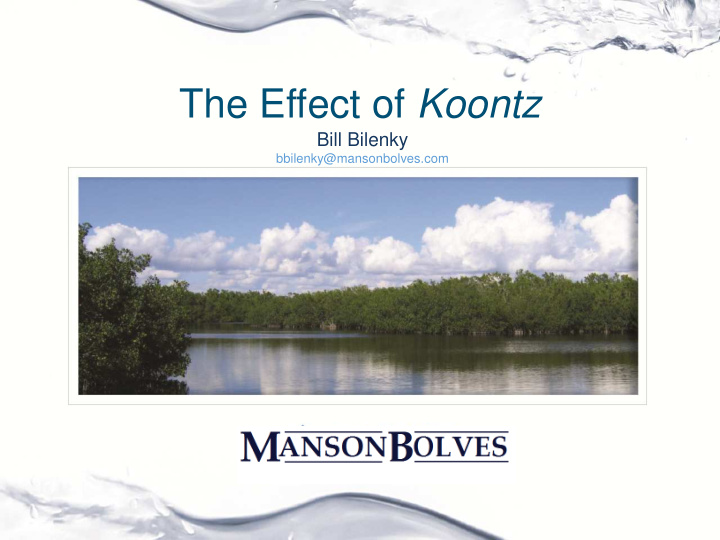



The Effect of Koontz Bill Bilenky bbilenky@mansonbolves.com
Case Study • Developer purchases three parcels, one of 70 acres, 9 acres and 5.88 acres as part of an “all or nothing deal” • Developer sells 70 acre parcel, develops and sells the 9 acre parcel and retains the 5.88 acre parcel. • Developer seeks an ERP to develop the 5.88 acre parcel that is comprised of 4.66 acres of wetlands and the remaining 1.22 acres is a narrow strip of uplands along the road frontage. • After some negotiations, developer proposes to destroy 2.83 acres of wetland and preserve and enhance 1.83 acres of wetland. • The parcel is in a closed basin and the 4.66 acres of wetland are integral to holding surface water runoff in an area that historically floods bbilenky@mansonbolves.com
District Decision The District denies the permit on three grounds: • Developer did not provide reasonable assurance that the development would not result in off-site flooding • The design did not minimize wetland impacts • Wetland mitigation would not offset adverse effects caused by the development. bbilenky@mansonbolves.com
DOAH Decision • In DOAH hearing Developer also contends that it would suffer a substantial hardship or a violation of principals of fairness entitling it to a rule variance or waiver pursuant to s. 120.542, F.S. • DOAH finds for the District. Nollan and Dolan both cited in the Appeal - bbilenky@mansonbolves.com
Conclusion • For permitting authorities like the Water Management Districts and the DEP, Koontz should have little or no effect. • The application of the UMAM methodology for permit issuance or the WRAP methodology applied by the U. S. Army Corps of Engineer, should establish the appropriate level of expenditure negating the question of arbitrariness or disproportionality. • The issue for regulatory agencies is to keep these “denials” out of being “takings cases.” bbilenky@mansonbolves.com
Recommend
More recommend